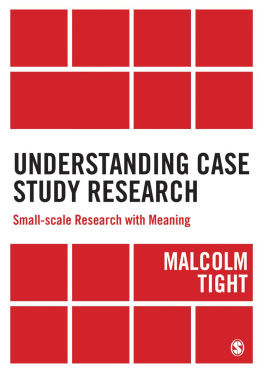SAGE Publications Ltd
1 Olivers Yard
55 City Road
London EC1Y 1SP
SAGE Publications Inc.
2455 Teller Road
Thousand Oaks, California 91320
SAGE Publications India Pvt Ltd
B 1/I 1 Mohan Cooperative Industrial Area
Mathura Road
New Delhi 110 044
SAGE Publications Asia-Pacific Pte Ltd
3 Church Street
#10-04 Samsung Hub
Singapore 049483
Malcolm Tight 2019
First published 2019
Apart from any fair dealing for the purposes of research or private study, or criticism or review, as permitted under the Copyright, Designs and Patents Act, 1988, this publication may be reproduced, stored or transmitted in any form, or by any means, only with the prior permission in writing of the publishers, or in the case of reprographic reproduction, in accordance with the terms of licences issued by the Copyright Licensing Agency. Enquiries concerning reproduction outside those terms should be sent to the publishers.
Library of Congress Control Number: 2018957573
British Library Cataloguing in Publication data
A catalogue record for this book is available from the British Library
978-1-5264-2664-2
978-1-5264-2665-9 (pbk)
Editor: Jai Seaman
Editorial Assistant: Charlotte Bush
Production Editor: Sushant Nailwal
Copyeditor: Sharon Cawood
Proofreader: Derek Markham
Index: Author
Marketing Manager: Susheel Gokarakonda
Cover Design: Shaun Mercier
Typeset by: C&M Digitals (P) Ltd, Chennai, India
Printed in the UK
At SAGE we take sustainability seriously. Most of our products are printed in the UK using responsibly sourced papers and boards. When we print overseas we ensure sustainable papers are used as measured by the PREPS grading system. We undertake an annual audit to monitor our sustainability.
Part 1 Starting Documentary Research
contains four chapters, which together provide an overview of documentary research in the social sciences and beyond:
provides an introduction to the book, explaining its purpose, content and different ways of making use of it.
considers the nature of documents, how they vary, the possibilities and advantages of documentary research, and how documents can be used in research, either as the focus of study or in combination with some other method or methods.
discusses the processes involved in finding and reading documents, including the use of search engines, ethical issues, sampling strategies, how to assess the veracity and usefulness of a document, and find what you want in it, and recording your research.
examines the uses of documentary research in different disciplines, both within the social sciences (anthropology, business/management, economics, education, geography, information science, law, media studies, political science, psychology, social work, sociology) and beyond (notably in health care/medicine and history).
What this Book is for
Documentary research is, arguably, one of the most overlooked aspects yet in many ways one of the most critical aspects of social research. Thousands of books have been written on social research, but only a relative handful has focused on documentary research. Yet all social research involves documents, even if only to provide a brief literature review to contextualise a study; while, in writing up social research, other documents are produced.
Indeed, some forms of social research (such as archival and historical research, policy research, secondary data analysis, systematic reviews and meta-analyses as well as literature reviews each of which are discussed in detail in of this book) rely heavily or exclusively on documents. Yet even these have only generated small, niche literatures.
Why documentary research appears to have been so overlooked is, therefore, worthy of some speculative discussion. Is it, for example, that reading, analysing and interpreting documents is taken to be such a basic skill that anyone with a reasonable level of education will already be competent enough to handle it? Or is it that the collection and analysis of new empirical data through surveys, experiments, interviews and/or observation is felt to be so much more important, and perhaps also more engaging or exciting?
Or maybe it is because documentary research is not a single, homogeneous entity, but includes, as has already been indicated, a range of approaches demanding separate and specialist treatment? This, however, is true of many social research methods or methodologies, so cannot be the main reason. Or perhaps, finally, it is simply that documentary research is so obvious as a generic social research technique that it is effectively invisible?
Each and all of these speculations may hold some truth, but each of them reflects views which must be questioned. Reading, analysing and interpreting documents is far from being a straightforward exercise, so some guidance may be useful and appreciated. Collecting fresh data for analysis is undeniably important especially for certain kinds of social research or certain topics but there is much more data that already exists, is relevant and is readily accessible (especially now that so much of it is available online), and often freely so, particularly to bona fide researchers.
While there are specific or specialised forms of documentary research, there is also a great deal of common ground between them, and generic approaches to documentary research and analysis are far more common; indeed as already argued endemic. So they deserve both some considered attention and care in application.
This book, therefore, sets out to provide an introductory, comprehensive, single-volume and up-to-date guide to documentary research. While its broad audience includes all of those studying or researching in the social sciences, it should also be of relevance to other disciplines for example, in the humanities and sciences that make extensive use of documentary research.
The underlying aim of the book is to provide the support which is largely lacking in the social research methods literature for those interested in and undertaking documentary research. While this is undeniably a broad and disparate group, and more specialist support will be needed for many, the general guidance given here should be, at the very least, a useful starting point.










